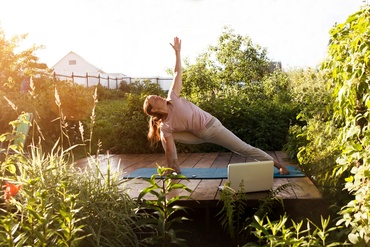
Find your zen in your own backyard by creating your own yoga garden. The ancient practice of yoga is a wonderful way to build strength and flexibility and feel connected to your body and the world around you. So, what could be better than your own yoga garden, a calm, tranquil space where you can be in touch with nature while you practice yoga or meditate? Here are a few tips on how to create your own yoga garden.
How to Make a Yoga Garden
-
The most important thing to consider when setting up your yoga garden is to make sure that there is a flat, level area where you can put down a mat and practice your yoga safely. The surface can be a paved or gravel area, wooden decking, or simply a flat lawn. However, remember that paving stones have absolutely no ‘give’ if you fall over onto them, even on a yoga mat, so a lawn or wooden decking may be a better choice.
-
If possible, place your yoga garden where you can benefit from the dappled shade under a tree. A pergola or arbour covered in beautiful climbing plants also makes a sheltered spot for yoga practice.
-
Large shrubs can provide screening for privacy and give a sense of shelter and protection. If you don’t have any suitable shrubs already in the garden, you could plant bamboo in large pots. Fargesia rufa, a relatively small clumping bamboo, is a good choice for pots. Nandina domestica, also known as heavenly bamboo, is actually an evergreen shrub with bamboo-like leaves, an ideal choice to provide beautiful year-round screening for your yoga garden.
-
Objects that symbolize some of the elements in Buddhist philosophy (air, water, fire, and earth) can provide focus for mindful meditation. A wind chime or a mobile hanging from a tree branch can help you to be aware of the movement of the air, and a water feature creates a feeling of peace and tranquillity. You could also take inspiration from Japanese gardens and create a dry water garden, using raked gravel to symbolize ripples on the surface of a pond. Boulders can represent the earth element in your garden, helping to keep you grounded. You can also achieve this by including a few pots in earthy red-brown and gold colours.
-
Add some cushions or a chair to create a comfortable space for meditation or reflection.
-
Sensory elements in the garden will help connect you to your environment. Plant grasses for sound and texture, as well as fragrant plants like lavender or roses. Cool colours like blue, green, and white are ideal for a meditation space, creating a tranquil, harmonious environment.
-
Any artwork that has meaning for you can create a focus for meditation in your yoga garden. This could be anything from a sculpture to a beautiful pot containing a favourite plant.
You’ll find a fantastic range of plants and garden accessories in our centre to help you create your ideal yoga garden. Visit us today to start making your dream garden come true!




